Please Take Note: This is a review of the final game, but it might change slightly based on the success of the Kickstarter campaign. The game is being reviewed on the components and the rules provided with the understanding that “what you see is not what you might get” when the game is published. If you like what you read and want to learn more, we encourage you to visit the game publisher’s website or visit the Kickstarter campaign. Now that we have all that disclaimer junk out of the way, on with the review.
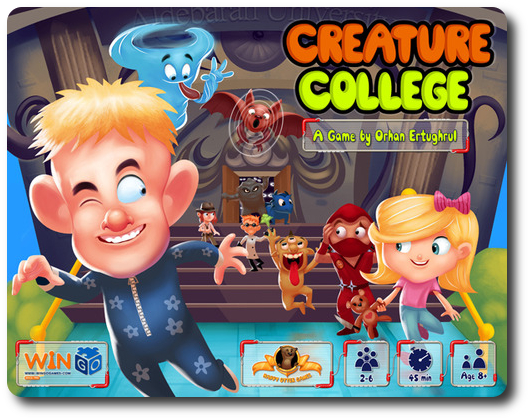
The Basics:
- For ages 8 and up
- For 2 to 6 players
- Approximately 45 minutes to complete
Geek Skills:
- Active Listening & Communication
- Counting & Math
- Logical & Critical Decision Making
- Reading
- Pattern/Color Matching
- Strategy & Tactics
- Risk vs. Reward
- Hand/Resource Management
- Bidding
Learning Curve:
- Child – Easy
- Adult – Easy
Theme & Narrative:
- To earn this college degree, you have to be a real monster
Endorsements:
- Gamer Geek approved!
- Parent Geek approved!
- Child Geek approved!
Overview
Millions of pamphlets are delivered to would-be students each year to inform them of exciting academic programs. But there is one college that keeps to itself and only invites a select few to attend. This is Creature College, and what it provides is so much more than a simple education. Here students will learn the art of capturing mythical creatures, training them to battle, and utilizing science to do the impossible. Welcome to your first day of class.
Creature College, designed by Orhan Ertughrul and to be published by Happy Otter Games, will reportedly be comprised of 6 Player mats, 54 Creature cards, 48 Battle cards, 36 Special Mission cards, 24 Ability cards, 36 “Battle Gem” Research Lab cards, 36 “Victory Point” Research Lab cards, 36 “Element Track” Research Cards, 1 game board, 150 “Battle Win” gems (in the color green), 50 “Battle Loss” gems (in the color red), 6 Player token sets (includes 5 square Element markers, 1 square Round Order marker, and 9 round Bidding tokens), 3 Kevin the Giga-Pig cards, 1 square Game Round marker, 2 Card dice (custom six-sided dice), and 1 scoring pad. As this is a review of a prepublished game, I will not comment on the game component quality.
But I will say this…
We were provided the cleanest, most professionally produced prepublished game copy you can imagine. It looks like a published game. Everything from the game’s box to the smallest game component looks and feels like a finished product. Artist Mike Legan has contributed colorful and whimsical illustrations to bring out the game’s lighter side without reducing the game’s more serious game play.
Preparing for the Hunt
To set up the game, give each player 1 Player mat randomly or have players select their own. The only difference between the Player mats is the character illustrations. After each player selects a Player mat, hand them their complete set of Player tokens. The tokens will be the same color as the Player mat. Place any Player mats and Player tokens not used back in the game box.
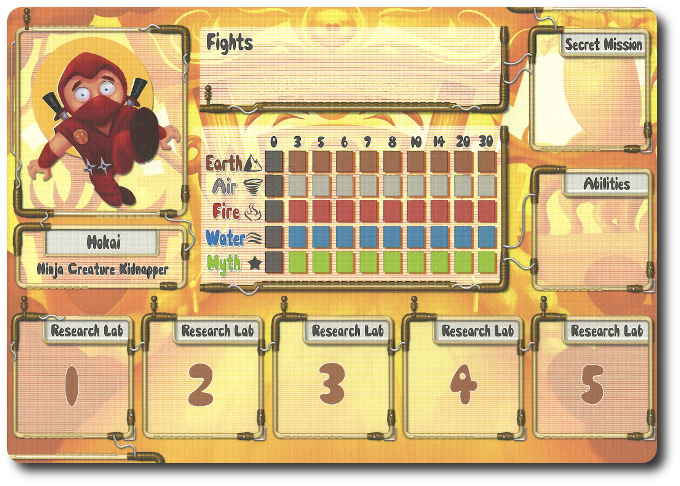
Second, place the game board in the middle of the playing area. Place the Game Round marker on the first Bidding round (on the left-most side) under the “Autumn” term.
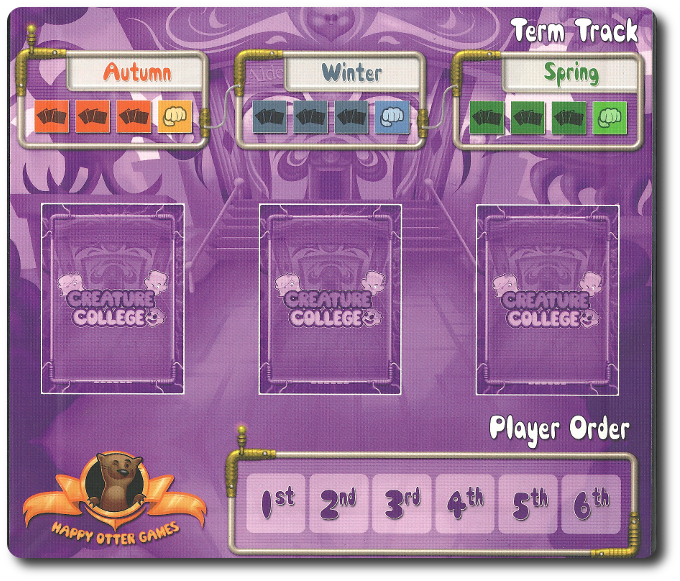
Third, collect the Creature cards and remove a number of specific Creature cards based on the number of players in the game. For example, if playing with 6 players, no Creature cards are removed from play. If only playing with 2 players, all Creature cards with the value of “1” and “2” are removed from play. Place the removed Creature cards back in the game box.
Fourth, shuffle the remaining Creature cards to create the Creature draw deck. Deal the Creature draw deck into 3 equal piles and place 1 Kevin the Giga-Pig card on top of each. Now shuffle each pile separately. These are still considered the Creature draw deck, but now it’s split into 3 different smaller decks. Place each draw deck face-down in “Autumn”, “Winter” and “Spring” spaces found under the “Term Track” on the game board.
Fifth, shuffle each of the 3 different Research card types in their own decks and place each face-down next to the “Term Track”, but off to one side of the game board. These are the Research draw decks for the duration of the game. Shuffle the Battle cards and place them face-down next to the Research cards.
Sixth, shuffle and deal 3 Ability cards to each player, face-down. Players review the Ability cards and select 1 to use during the game, placing it face-up on their Player mat. All Ability cards not selected are returned to the game box.
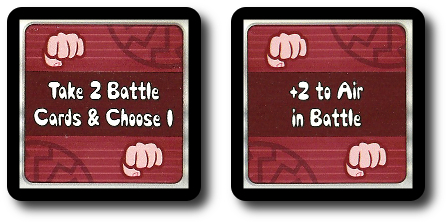
Seventh, shuffle and deal 3 Mission cards to each player, face-down. Players review the Mission cards and select 1 to use during the game, placing it face-down on their Player mat. All Mission cards not selected are returned to the game box.

Eighth, place any remaining game components to one side of the game playing area.
That’s it for game set up. Determine who will be the first player and begin.
Creature Catching
Creature College is played 12 rounds. Rounds are divided up into 3 terms (“Autumn”, “Winter”, and “Spring). Each term has 3 bidding rounds and 1 battle round at the end. The game ends when the 12th and final round is completed. A bidding and battle round are summarized here.
Bidding Round
There are 3 bidding rounds per term for a total of 9 bidding rounds in the game. The bidding round focuses on collecting Creature cards. Collected Creature cards will be used to fight other player’s Creature cards at the end of the term. If it helps, think of this part of the game as drafting an army. During the bidding rounds, it’s possible that Kevin the Giga-Pig will be drawn which will cause problems for everyone.
Step 1: Draw Creature Cards
The Creature cards are found in the 3 term Creature draw decks. Draw 1 Creature card per player from the appropriate term (start with “Autumn”, then “Winter”, and finally “Spring”). The Game Round marker will indicate which Creature draw deck should be used.
Drawn Creature cards are placed in the middle of the game playing area, face-up. The number of Creature cards available is dependent on the number of players. For example, 6 Creature cards are drawn for a 5 and 6 player games and only 4 Creature cards are drawn for a 3 and 2 player game.
Step 2: Bid on Creatures
If this is the first bidding round in the first term, all players should now have their Bidding markers face-up in front of them. Number values range from 1 to 9. Once used a Bidding marker is unavailable for the duration of the game. Each player will have enough Bidding markers to participate in the 9 bidding rounds, but they will need to be thoughtful about how they spend them or they might end up “winning” Creature cards that don’t help much.
In turn order sequence, each player places 1 Bidding marker on an available Creature card, face-up. The next player in turn order sequence can bid on the same Creature card as another player, but they must place a Bid marker with a higher value. This might cause a chain of events that must be resolved before the bidding continues. A player can also bid on a Creature card without any Bidding markers.
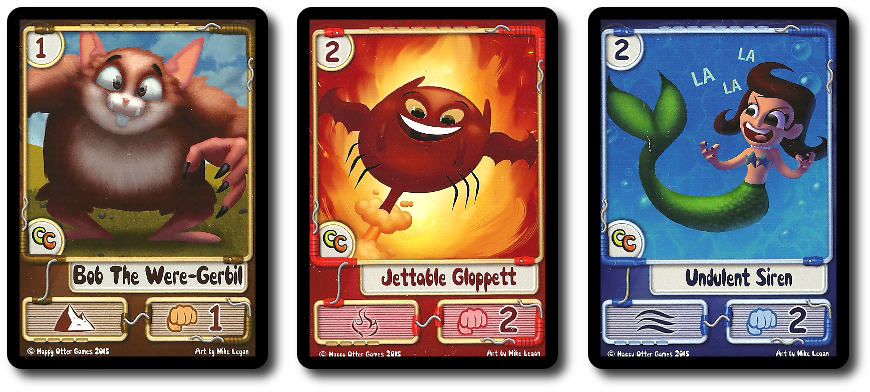
There’s no such thing as a “bad creature”, but some will be more helpful to the player than others
If a Bidding marker is placed with a higher value than the currently placed Bidding marker, the Bidding marker with the lower value must be moved. The player who owns it can move their Bidding marker to any other Creature card as long as their Bidding marker has the highest value or is the only Bidding marker on the card. If the placement of the bumped Bidding marker bumps another player’s Bidding marker, it must also be resolved immediately. And so on until everything settles down and the next player in turn order sequence who has not yet placed their Bidding marker gets to bid on a Creature card, possibly starting the chain of bumps again.
A player cannot place a Bidding marker of the same value as another Bidding marker on the same Creature card. The player who placed the first Bidding marker gets precedence. This means a “9” Bidding marker is unbeatable and an “8” Bidding marker is only beatable with a “9” Bidding marker.
There are a few exception to the bidding rules. Some Ability cards allow the player to bend or break the normal flow of bidding. Each player should consult their Ability card to ensure they are taking full advantage of their special and unique perk.
Step 3: Adjust Player Order
All of the bids are now placed. The turn order sequence is now adjusted based on the Bidding markers used. The player who placed the highest bid becomes the first player. The player to place the second highest becomes the second player and so on. If there are 2 or more bids of the same value, those players do not change their position, but might shift based on the bidding from their opponents.
Step 4: Collect Creatures and Adjust Elements
The Creature cards are now collected by their new owners and the Bidding markers are placed face-down to signify they can no longer be used.
Creature cards are associated with different elements (Earth, Fire, Air, Water, and Spirit). It helps some players to think of these as different card suits. Each time a player collects a Creature card, they adjust the Element track on their Player board by +1, shifting their marker to the right.
There are “Wild” Creature cards that are not specifically aligned with any element type. As such, they are not recorded on the Player mat until the end of the game. However, “Wild” Creature cards can be used to complete certain Mission cards. In which case, the player will have to align the “Wild” Creature card with a specific element, but only when they complete the Mission card.
Step 5: Roll for Research
In turn order sequence, players roll the Card dice. The dice will randomly determine how many “Battle Card”, “Victory Point”, “Gem”, and “Elemental Track” Research cards the player can collect. At the least, a player will collect 1 card and at most 2 cards. One die will roll a number and the other will roll the Research cards that the player can select from. After rolling and selecting their cards, the dice are passed to the next player in turn order sequence.

The three different areas of research are as follows:
- “Gem” Research cards adjust the number of “Battle Win” gems a player collects if they are victorious in battle.
- “Victory Point” Research cards give victory points at the end of the game.
- “Element Track” Research cards adjust the total number of points a player can earn based on their Element Track (moving the markers 1 or 2 spaces).
Research cards are placed face-up in front of the player on the Player mat. Battle cards are kept hidden and can remain in the player’s hand or placed face-down in front of them.
Players should thoughtfully consider which of the Research cards they are collecting. Once a Research card is placed in 1 of the 5 slot spaces on the Player mat, they are locked. This means a player can only collect, at most, 5 Research cards. If a player locks all 5 of their Research slots early, they must take Battle cards. Which is not a bad thing.
Once everyone has finished rolling and collecting cards, the round ends and a new round begins. All the Creature cards not collected during the bid are collected and removed from the game. The Turn marker is advanced to the next space. If another round of bidding is needed, draw new Creature cards and begin again.
Oh, Crap! It’s Kevin!
During the Bidding round, it’s possible that Kevin the Giga-Pig will make an appearance. In total, this can only happen 3 times during the game. If Kevin is drawn, all players will have to fight this 60-story mutant guinea pig at the END of the current Bidding round. This is not a battle the player’s can avoid and the game cannot continue until Kevin is dealt with.

Each player selects 1 element and gathers those Creature cards in front of them. A player need not use all the Creature cards in their selected element type. Any Creature cards that are used when battling Kevin CANNOT be used in future battles in the game, both attacking and defending.
Kevin has a strength value (found next to the fist symbol) and a number of “Battle Loss” gems. Players combine the strength values of all their selected Creature cards and any Battle card bonuses. If the Strength value is equal to or higher than Kevin’s strength value, they have merely defended themselves against Kevin. Kevin is not defeated, and as such, players do not collect “Battle Win” tokens. If the combined strength value is less than Kevin’s strength value, the players take 3 “Battle Loss’ tokens.
After each player has had a chance to go toe to toe with Kevin, the game continues. Creature cards that were used should be placed at a 90 degree angle to signify they are no longer available for battles.
Battle Round
After 3 rounds of bidding, the final round of the term is a battle between the players and their collected Creature cards. Keep in mind that Creature cards can only initiate a battle once per game. This includes battling with other opponents and Kevin.
In turn order sequence, each player selects 1 Element type and takes any number of Creature cards they have that match the selected element. Players must use at least 1 Creature. The player then announces if they are attacking the opponent on their left or on their right, rotating the used Creature cards to indicate they have been used.
The defending player then uses as many Creature cards as they like to defend the attack. The Creature cards must match the selected element used by the attacker. Both sides can use Battle cards and the defender can use 1 “Wild” Creature cards to assist in the battle.
When all the Creature cards are selected and Battle cards played, both players compare their total strength by adding the individual strength values provided by their Creature cards and any Battle cards. The player with the highest total strength wins the battle! If the attacking player wins, they receive 2 green “Battle Win” gems. I they lose, they receive 2 red “Battle Loss” gems. The number of gems given will be modified by Research Lab cards. Defending players never receive any gems.
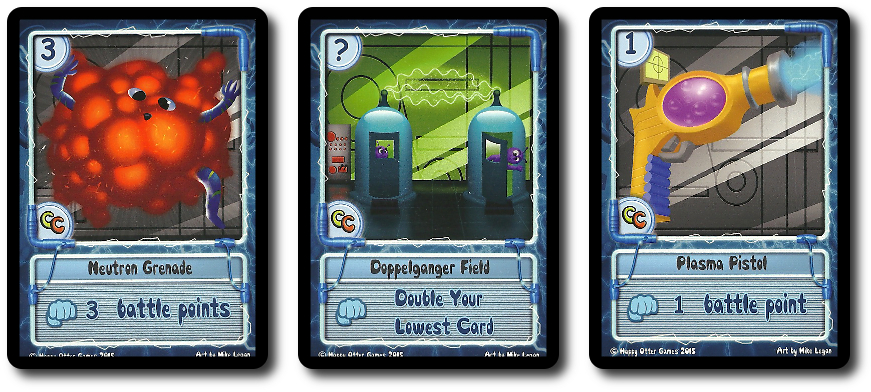
Battle cards are incredibly powerful, but can only be used once
After the first battle is over, the player attacks the opponent on their other side using the same Creature cards they selected. Previously used Battle cards are lost, but additional Battle cards can be played during the second battle. Again, the winner is determined and the player receives gems. The Creature cards the player used in the battles are no longer usable to attack or to defend. Creature cards used to defend are still available to attack.
If playing a 2-player game, only 1 battle is completed per end of term.
After the player has completed their battles, the next player in turn order sequence takes their turn and battles their opponents. This continues until all the players have had a chance to battle. Once the battles are over, the next round begins and the Game Round marker is moved forward.
End of School Year
The game continues until the last battle in the “Spring” term is completed. Players now add up their points to determine who won. Use the Score pad to assist in recording each player’s score.
- Add up the victory points earned from each Elemental type collected and tracked on the Element Track found on the Player board. The victory point values are noted at the top of each column.
- Each player flips over their Mission card. If they completed it, they receive the victory points noted on the Mission card.
- Earn +1 victory point for every 1 green “Battle Win” gem.
- Lose -1 victory point for every 1 red “Battle Loss” gem.
- Add any victory points earned from “Victory Point” Research cards attached to the Player board.
The player with the highest combined total of victory points is the winner! Ties are broken by total number of “Battle Win” gems.
To learn more about Creature College, visit the game publisher’s website or visit the Kickstarter campaign.
Final Word
The Child Geeks were fascinated with this game. If they weren’t jabbering on excitedly about the different Creature cards, they were discussing all the many ways they would use their Battle cards. For the older child geeks, much of the game was spent trying to maintain a standing army of creatures and collecting points by utilizing their bidding power in such a way as to always get good cards. The younger Child Geeks didn’t give two hoots about bidding power and just went for the Creature cards they liked best. In both cases, the players had a good time. According to one Child Geek, “I really like all the different Creature cards and the different ways you can use the Battle cards. It makes each fight fun.” Another Child Geek said, “You have to think about what you are doing, but it’s not hard to figure out what to do next.” All of the Child Geeks demonstrated a strong grasp on the game’s principle mechanics and even demonstrated a lot of strategic and tactical game play. When all the games were over, the Child Geeks voted to approve the game.
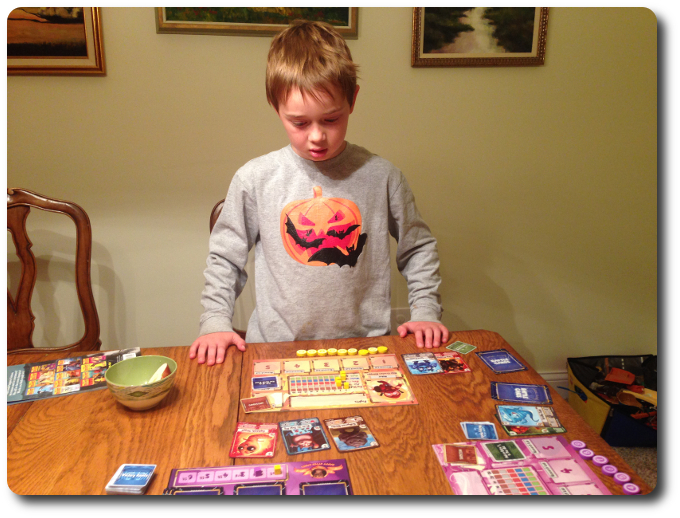
That look you get when you can’t defeat Kevin…
The Parent Geek were very grateful for this game. According to one Parent Geek, “Oh, thank God! I was absolutely certain I was going to have to teach my children Settlers of Catan if I wanted them to learn Euro games. Looks like I don’t have to! And this game is so much better!” Many of the Parent Geeks recognized that the game had two big draws. The first was the game’s looks, which were colorful and clearly targeting children. Second, the game play was engaging, but not overly demanding. As one Parent Geek put it, “This is the perfect game for my family. It plays fast, keeps you interested, and you have to think through your moves. This game really nailed it.” All the Parent Geeks agreed that Creature College was a game that would be warmly welcomed by their families and their friends.
The Gamer Geeks didn’t care for the game’s looks, finding the illustrations and the game’s theme to be uninteresting and childish. But that’s where the Gamer Geek’s negative comments ended. The rest of the game they very much enjoyed. According to one Gamer Geek, “It’s a shame about the game’s theme. I’d want to play this game a lot more if it was adult or gamer-focused. As it stands, I don’t care for its looks, but I love how it plays.” Many of the Gamer Geeks wrestled with what was more important: style or substance?. In all cases, substance won out. As one Gamer Geek put it, “What it comes down to is the game’s quality of play and this game has a lot of quality. This is the kind of game I’d happily play with anyone at anytime.” All the Gamer Geeks agreed that Creature College was a light and engaging game, full of interesting decisions and fun player interaction. They suggested it would be best played with mixed skill groups or as a light filler for the gaming elitists.
Creature College has something for everyone. The Child Geeks loved the Creature card collection and combat, which reminded them of other card games like Pokémon and Yu-Gi-Oh! The Parent Geeks liked the casual, yet quick paced game play that kept them engaged from start to finish. The Gamer Geeks appreciated the game’s surprising amount of depth that demanded strategic and tactical plays. Creature College tickled the fancy of our most inexperienced players to our most elite, but more importantly, it was a game all three groups could play together at the same time.
I was very surprised by the game. The box and artwork would suggest an experience full of lighthearted shenanigans, but don’t you believe it. Creature College can be unrelenting and ruthless. You only win by climbing on the backs of the bruised. You have to do everything you can to out bid and out battle your opponents so you can win in the end. The different ways to gather victory points makes it absolutely necessary to keep your eyes on your opponents’ progress so you can take advantage of specific areas of the game they are ignoring or address threats in areas where you are not well suited to compete. This is a game of finding balance and order where there is none. Everything from the creatures you collect to the way you build your lab is important, but the weight of these decisions never once feels heavy.
I would recommend Creature College to Child, Parent, and Gamer Geeks. The only group this game would not be well suited for are the hardcore game players who need the grit and the grind to have a good time. Creature College plays for keeps, but is a very friendly game. If you have young Child Geeks who are looking to play a Euro game, adult friends who are sick of Settlers of Catan and want something knew, or a Gamer Geek who wants a light game with deep game play, then do check out Creature College.
And, yes, fear Kevin, too.
This is a paid for review of the game’s final prototype. Although our time and focus was financially compensated, our words are our own. We’d need at least 10 million dollars before we started saying what other people wanted. Such is the statuesque and legendary integrity of Father Geek which cannot be bought except by those who own their own private islands and small countries.



